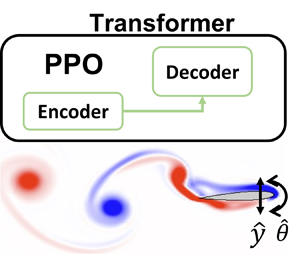Published online by Cambridge University Press: 27 March 2024

To optimize flapping foil performance, in the current study we apply deep reinforcement learning (DRL) to plan foil non-parametric motion, as the traditional control techniques and simplified motions cannot fully model nonlinear, unsteady and high-dimensional foil–vortex interactions. Therefore, a DRL training framework is proposed based on the proximal policy optimization algorithm and the transformer architecture, where the policy is initialized from the sinusoidal expert display. We first demonstrate the effectiveness of the proposed DRL-training framework, learning the coherent foil flapping motion to generate thrust. Furthermore, by adjusting reward functions and action thresholds, DRL-optimized foil trajectories can gain significant enhancement in both thrust and efficiency compared with the sinusoidal motion. Last, through visualization of wake morphology and instantaneous pressure distributions, it is found that DRL-optimized foil can adaptively adjust the phases between motion and shedding vortices to improve hydrodynamic performance. Our results give a hint of how to solve complex fluid manipulation problems using the DRL method.
These authors contributed equally to this work.